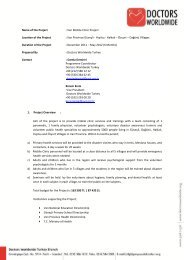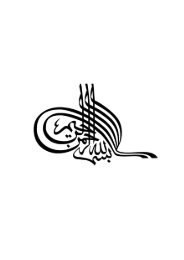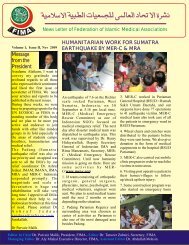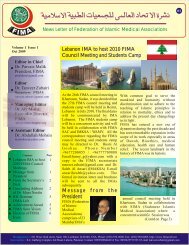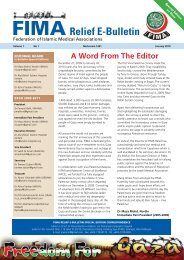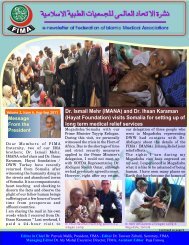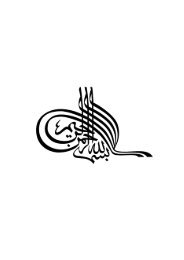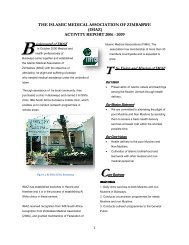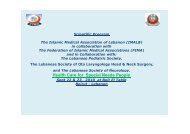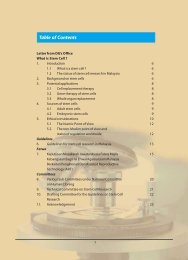FIMA Year Book 2009 - Federation of Islamic Medical Associations
FIMA Year Book 2009 - Federation of Islamic Medical Associations
FIMA Year Book 2009 - Federation of Islamic Medical Associations
You also want an ePaper? Increase the reach of your titles
YUMPU automatically turns print PDFs into web optimized ePapers that Google loves.
Muslim Contributionsswept across the <strong>Islamic</strong> world andEurope and thousands <strong>of</strong> people dieddaily. The population <strong>of</strong> Egypt, Syriaand Iraq was reduced to one third.Several epidemics <strong>of</strong> plague recurred inEgypt and Syria in 1363 and 1515 C.E.These recurring natural disasters anddisease epidemics affected agricultureand animal husbandry leading tocollapse <strong>of</strong> these industries due todeath <strong>of</strong> skilled workers. These factorsaccelerated the process <strong>of</strong> economicdecay. This, coupled with the declinein political stability, led to a lackconducive environment for knowledgeand science to thrive because society’spriority had to be refocused.Attacks from external enemiesThe Muslim world, at its height wasattacked by two sets <strong>of</strong> invaders, onefrom the West and the other from theEast. From the West came the EuropeanCrusaders. Seven Crusades werewaged against Syria, Palestine, Egyptand Tunisia between 1096 – 1291 C.E.These Crusades helped Western Europeto grow united on all fronts and helpedincrease trade and capital amongthemselves (32) . New maritime colonieswere developed under Crusaders`rule and they survived the Muslim reconquest(33) . Syria and Egypt struggledtogether under the Ayyubids and theMamlukes and adopted a militarysystem that defeated and expelledthe Crusaders. The efforts to stop theCrusaders weakened the Muslim worldand their economy for two centuries.After the unsuccessful Crusades, TheWestern forces also attacked the cradle<strong>of</strong> knowledge in Andalusia, carving outbit by bit the Muslim land until the lastbastion in Granada fell in 1492 C.E.While the Western front was busyrepelling the Crusaders, a bigger andmore formidable threat emerged, thistime it came from the East. By themiddle <strong>of</strong> the 13 th century, GenghisKhan united the nomadic tribes <strong>of</strong>Mongolia and attacked the Eastern<strong>Islamic</strong> lands. Samarkand, Bukharaand Khwarizm were conquered anddestroyed by them. In 1221 CE theyentered Persia. Another invaderfrom East, Hulagu together with hisarmy <strong>of</strong> 200,000 men marched witha plan to conquer all <strong>Islamic</strong> lands asfar as Egypt. He managed to conquerBaghdad in 1258 CE and killed theAbbasid caliph al-Musta`sim andabolished the caliphate. The riverEuphrates was reported to be a mosaic<strong>of</strong> red and black from the blood <strong>of</strong>Muslims killed and from the ink <strong>of</strong>countless books thrown into the river.This was the beginning <strong>of</strong> the end <strong>of</strong> thegreat <strong>Islamic</strong> civilization on the Easternfront, more than two centuries beforethe fall <strong>of</strong> Granada.These invasions and assault on theMuslim land led to massive massacresand significant loss in terms <strong>of</strong> humanand other valuable resources. TheMongols slaughtered up to 2 millionpeople in Baghdad alone (34) . Thiscontributed greatly to the process<strong>of</strong> depopulation and decline <strong>of</strong>civilization. The Muslims however<strong>FIMA</strong> <strong>Year</strong><strong>Book</strong> <strong>2009</strong>111




